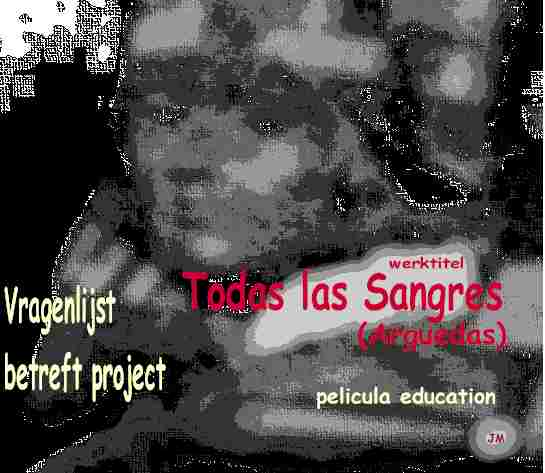 |
||

Proposal For 5 educational films by Joke Menssink Todos las Sangres (working title) (Arguedas, free translation: The paths of the blood) Niway piwanmi purinki, ñoga nisqayki pin kanki. Tell me who you walk with, and I’ll tell you what kind of person you are
To Jean Schmitz Country Manager MSF Holland Peru To the members of the Board of MSF United States To Annette Kuipers Project coordinator MSF Holland Huancavelica AIMS -To create 5 educational films of ± 15-20 minutes based on the following subjects: Basic hygiene- Diarhea- Lung and skin infections - Family planning - Vaccinations - Risk factors for pregnant women. -The targetgroups will be the villagers in the province Huancavelica. -The language will be in Quechua. ( a Spanish subtitled copy of each film will be available for the workers). -The teams of MSF will have to make a work manual /sheets for the fieldworkers (In the future these workers will be from Minsa) IDEA The plan is not to make plain instructionfims but to add an entertainment value to the intended videos, based on current issues which are traditional, and for the spectators recognisable, as wellas important and amusing.This all ofcourse, without losing the educational value. The main course in realising this project will be: to involve the local people in making the films so that they will seethat this is not something coming from strangers, who know what is best for them. These films should serve as a bridge to connect the cultural thinking and traditions of the people living here with modern ideas of healthcare. They should also strengthen self-esteem and encourage curiosity to learn about new things. To make only the films is not enough. It is also necessary to construct a work manual for the healthcare workers with clear information, pictures and instruction onhow to present the educational videos Each film will be made in such a way that it can be watched independently of the others, but it would be good to fit them in a context that will give it the effect of: "to be continued". In that way it will activate the interest in the other four videos. This couldbe achieved by introducing a main character who could forge the five parts into a one piece story. Such a character could be a known, respected person from one of the villages, or a continously questioning child, or a combination of the two, a duo, representing the values of traditional thinking as well as a modern look to the future. In the rough research I did until now, it became clear that there are some important facts agreed upon by everybody I spoke to. These are: --The villagers are not used to television although they like it very much. So the information must be simple and clear and not too much. (don´t use fast or abstract techniques) --The time of concentration of the villager is very short. So to use repetition of the important facts from different angles is necessary. --The structure that the fieldworkers of MSF prefer is that they can stop the video at certain moments to communicate with the villagers. -- We choose to use songs ( The message will be composed through words on well- known melodies in the styles of the different groups of indians) because they like it and it is connected to their culture. And also because in singing you can use the repetition of the message very easily without being boring. Also there is a possibility to sing the message together. --We have to be careful with the different groups of people; the different clans (Ajus). When we choose the people who appear in the video we must search for those who are accepted by everyone. --We have to use humor as it is obvious that the Quechua language is full of small jokes.This will serve both to explain and in a figurative way to teach and express values. -- We have to use images more then words to pass the information, because to use many words has not worked in the experience of the MSF workers) --It is very important to attract people from Minsa, also to involve them in the making of these films, because next year they have to take over the work. PLANNING AND STRUCTURE OF WORK As you can see in my CV , I always work with the same methology. After the interviews I make a synopsis upon which I base some workshops. This method gives the opportunity to work with all concerned members of the organisation. In this case the teams and coordinator of the Huancavelica project. Also the production design can be made easily, because together the know all possibilities and limitations. I always choose one person out of the concerned group with whom I work closely. When it is possible this person become the production leader. In this case I asked Leo from the Acobamba team.He used to study anthropology, and knows a lot about all the different "Ajus" and is also doing financial work now.
March 1999 Research - first round of interviews
April Workshop with all workers of the MSF team
June Scenario set up
July Scenario and production preparation -Workshops with singers from different Ajus to create the songs. -Search for people who appear in the films. -Scenario workshop with the design team and -Final decision making. -Production preparation.
August Shooting
September Postproduction -Editing in the Netherlands -Creating the work manuals in Peru
October Presentation and premiere of the movies. © VOOR TVF productions Joke Menssink 19 March 1999 Email menssink@dds.nl
(http: \\ ps.superb. net/diagonaal On this homepage you can see what work I made and make with artists with a physical disability, national and international. |
||
